Despite what many ads depict, divers don’t usually look like models underwater. Snot often drips from our nose; neoprene exposes every bulge; drysuits packed with layers mold into shapeless lumps; and hair is bedraggled. While your focus should primarily be enjoying your time underwater, you still want to look good in that image that’s going to appear on Facebook later. Here we’ve compiled our best 13 tips on how to look good in underwater photos to ensure you end up with a social-media worthy shot.
A note of caution: Safety is far more important than posing for a photo. Observe safe practices and only dive within your limits. Don’t attempt tricky shots unless you’re an advanced diver with great buoyancy. Further, avoid touching anything underwater — even the ocean bottom. It’s not only safer for you and better for the marine life, but it’ll also ensure that fellow divers admire your photo instead of upbraiding you for it.
Watch out for bubbles and deep breaths
Bubbles can be distracting in a photo and sucking down a deep breath results in an oddly bloated appearance. Either ask the photographer to time the photo on your inhale before bubbles appear or hold just a tiny breath for a few seconds.
Focus on your eyes
Prevent eyes from seeming small, dark, cross-eyed, scared, confused, or angry in underwater photos with one or more of the following techniques:
- Smile and remember something joyful. Even unseen smiles on your lips result in eyes with a happy gleam.
- Widen your eyes slightly.
- Black-skirted masks cast shadows, so choose a clear-skirted mask to pull in more ambient light as well as light from strobes. A small touch of color on a mask can also draw attention to your eyes.
- When engaged with something close by (e.g., a seahorse), focus your eyes slightly past that thing to prevent the cross-eyed look.
- Though we often prefer the roll-out-of-bed-and-jump-into-the-ocean look, apply some waterproof mascara/cream eyeliner or glue on eyelash extensions for special effect.
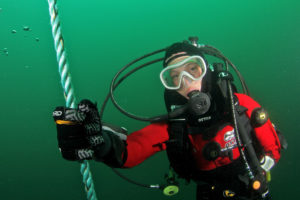
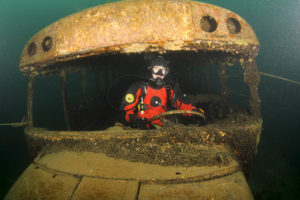
Give and take in equal measure
If you’re a photographer, offer to spend an entire dive shooting photos of someone else in return for the same favor. You’ll be surprised how many of your dive buddies will jump at the chance for a good photo of themselves.
Figure out your hair
Long hair easily mimics a weird clown’s wig or bedraggled seaweed underwater. Figure out the best way to handle your hair with one of these methods.
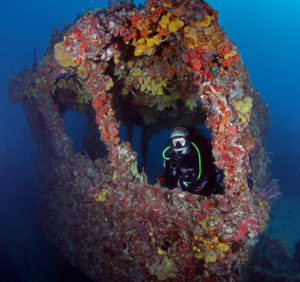
No. 1: Let it hang loose, but discover how to play with it underwater. Hair randomly floating above your head rarely looks good. Instead, try one of these options:
- Propel yourself a few inches backward by fluttering your hands down low in front of you. This can push hair forward in a beautiful way to perfectly frame your face.
- Swim a few inches forward to stream your hair behind you—ideal in far-away shots, silhouette shots, and shots which aren’t head on.
- Use one or both of your hands to fashion a dramatic shape to your hair such as curving it to one side.
- Gently sway your head back and forth to shape an interesting outline and an overall dramatic effect.
No. 2: Identify your best style for tying it back. (Check out our article on Top Tips to Tame Your Diver’s Mane for tips.) A friend of ours exchanged her two pigtails for a low ponytail covered with a hair wrap and her photos jumped from cute to gorgeous.
No. 3: Place your hair under wraps in a hood or a do rag. A do rag can inject some personality and draw attention to your face, but you can still create a great image even in an all-black hood if you focus on your eyes as noted above.
Skirt the middle
People appear better in underwater photos very close or far away. The middle distance is rarely effective because you’re too far away to be well lit, but still too large to balance the shot’s composition.
Plan the photos and use your best angles
Work to determine how your body looks best underwater and in what positions by testing out every angle imaginable on a series of dives with a photography partner. Then, before entering the water next time, talk to the person photographing you about your best poses.
For example: Even in the first photo of the exact same doll, the three dolls seem different. The angles, how their body is positioned, and the way the light hits each of them emphasize different aspects, such as how the doll on the left seems to have lighter hair and a thinner face.

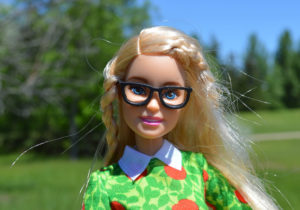
In the second picture, the same glamorous Barbie appears drab with messy hair, different lighting, and less photo editing while shadows from a black mask (or glasses in this case) impart shadows detracting from pretty eyes. The doll’s right eye even seems bigger than her left because of this.
Take lots of shots
Even the best photographers shoot more than one photograph of the same subject. Request plenty of shots if you can and vary your poses so you can pick the best of the bunch.
Be mindful of colored gear
Coordinating colors or all black can both equal a good portrait. Just plan your colors since a tiny bit of random color can be distracting (e.g., a bright orange safety sausage hanging off your hip).
Model elegant, long lines
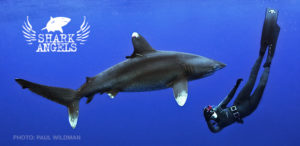
Your arms, hands, legs, and feet function as finishing touches for a pose. Extend your legs and keep your fins together for elegant, long lines. Tuck in your elbows and envision graceful fingers.
Don’t face the front of your body toward the camera for a full-body shot. This often results in a potato-like shape. Instead, turn your head toward the camera with your body sideways/angled up or down, or curve into a long, lithe shape.
Conquer neutral buoyancy and proper trim
Shooting someone who’s uncomfortable underwater is challenging because a moving body can blur and limbs can appear awkward. Without good trim, your body can be oddly positioned with your head down too low or up too high. Attend a buoyancy specialty course to become a better diver and your photos will improve as well.
Streamline your gear

All those dangly bits of gear produce drag, which increases your air consumption, can damage marine life, and looks horrible in photos. Streamline your gear and you’ll look more graceful. Also, if you use a BCD, pull it down tighter on your shoulders so it’s not floating up and conveying the illusion of no neck.
Edit the photos
Even cheap editing programs can produce better photos, balancing out the green or blue of the water, cropping extraneous space, improving the contrast, and more. Simple changes can play up the details and colors so the picture pops. Switch some shots to black and white for more drama.
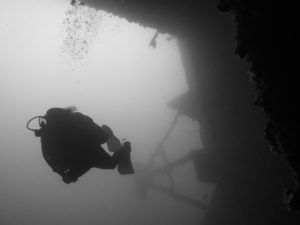
Get creative, dramatic, or silly
Forget those boring “Hi, Mom!” straight-on poses where you’re flashing an ok sign or throwing that surfer hang-loose sign. Try removing your regulator (in a safe manner) and smiling, or better yet, channel your inner model and vary your poses with:
- Silhouette shots
- Photos where you’re framed by a wreck or a circling school of fish
- Interesting angles where you’re curved around an object
- Wide-angle shots with you diving as a more natural part of the overall scenery
- Candid shots instead of just posed portraits
- Ridiculous poses for an element of childlike silliness
Requesting different techniques from the photographer can also increase the dramatic factor, such as the use of a fish eye lens or swirling shots.
Remember that neither fish nor your dive buddies care how you appear underwater. The best shots are the ones where you feel happy, you’re diving safely within your limits, and you’re having a great time underwater.





